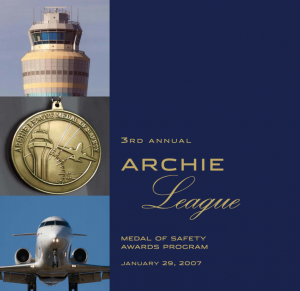
2007 – Winners of the 3rd Annual Archie League Medal of Safety Awards, honored on Jan. 29, 2007 at the Hyatt Regency Capitol Hill in Washington, D.C.:
Alaskan Region: Jonathan Eisenmayer, Fairbanks Tower/TRACON
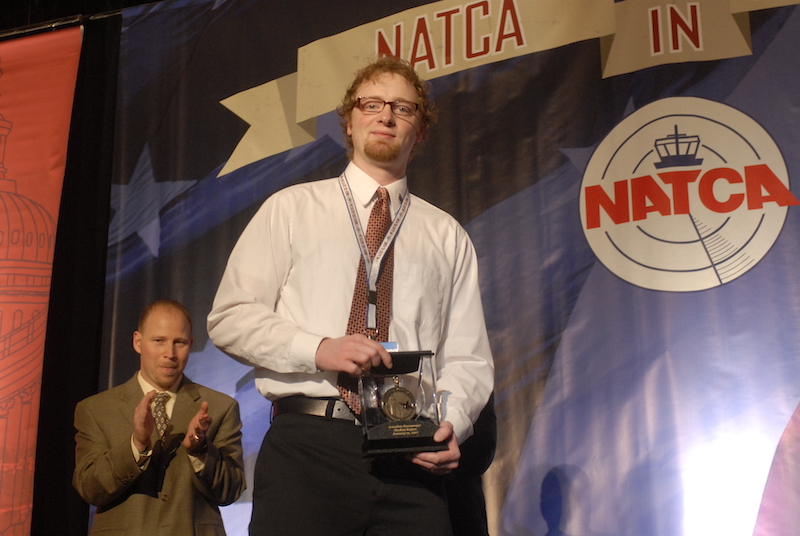
Air traffic controllers who work inside airport towers are responsible for many different functions, including – but not limited to – clearing planes for takeoff and landing and instructing pilots as to which taxiways they need to take to get on and off the runways.
A controller may tell a pilot to taxi to Runway X via Taxiway J and hold short prior to clearing the plane for takeoff. The same scenario occurs when a plane lands at the airport. It is important that the air traffic controllers monitor their radars and continually look out the tower windows to scan the airport for potential problems on both the runways and taxiways.
In Fairbanks, Alaska, controllers handle many general aviation flights all year long, but the number of aircraft going in and out of the airports can grow especially large during the fall and summer seasons. On September 8, 2006, during the prime fall hunting season, Fairbanks controller Jonathan Eisenmayer was working local control with a slightly larger than average load of aircraft coming in and out of Fairbanks International Airport (FAI).
Aircraft N3536G radioed the tower for clearance to takeoff. With another aircraft, WAV501, on a 1.5-mile final approach, Eisenmayer instructed N36G to hold short of the runway, to which the pilot responded, “Holding short, ready for takeoff.”
Eisenmayer then turned his attention away from the holding aircraft and towards a runway crossing he was handling downfield. Upon completion of the crossing, Eisenmayer scanned the runway and noticed N36G positioned on the runway ready to depart as WAV501 was fast approaching.
Eisenmayer quickly assessed the situation and determined there was not enough time for N36G to exit the runway prior to WAV501 attempting to land, so he instructed WAV501 to go around and then told N36G to exit the runway.
Eisenmayer then called N36G on his radio and told him that he was not issued a takeoff clearance and that he needed to report back behind the hold lines.
With a third aircraft on a 1.5-mile final approach, N36G was again instructed to hold short of the runway, to which the pilot read back, “Holding short, ready for takeoff.”
As Eisenmayer watched, N36G appeared to cross the hold lines once again. Eisenmayer again instructed the pilot to hold short. Finally, the pilot understood what was meant by hold short and complied, allowing the third plane to land safely prior to his own departure.
The quick thinking on the part of Eisenmayer to scan the airport for trouble, even after confirming with the pilot to hold short, prevented a runway accident from occurring at FAI.
“This type of save is the very essence of why we have controllers with binoculars in towers at most of the busy airports,” said FAI Facility Representative John Brown. “Eisenmayer’s actions were very quiet but likely prevented a ground collision.”
Read transcript of event highlights.
Central Region: Chris Thigpen, Kansas City Center
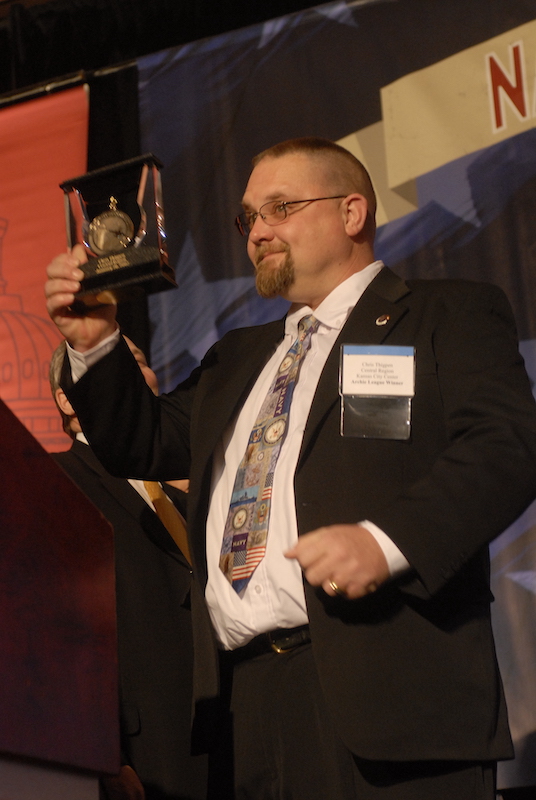
To a distressed pilot, the calm reassurance of an air traffic controller’s voice is their lifeline to safety. Even experienced pilots encounter trouble and must rely on controllers to guide them home. On Oct. 10, 2006, Charles Schultz, piloting his Beech Bonanza (N1801V), found himself in this situation and turned to Kansas City Center (ZKC) controller Chris Thigpen for guidance.
Schultz was headed from Scott City, Kan. (TQK), to Hays, Kan. (HYS), when another ZKC controller, John Bloomingdale, noticed the Bonanza making erratic turns. He radioed Schultz to ask his heading and when it did not match what the radar indicated, Bloomingdale assigned Schultz a different heading. But Bloomingdale knew the Bonanza was in trouble.
Bloomingdale declared an emergency and turned to Thigpen, who was working the next position, for help. Bloomingdale knew that Thigpen, a private pilot, would be able to assist Schultz. This decision proved correct, as Thigpen would spend the next 30 minutes guiding the Bonanza to safety.
Thigpen sat down next to Bloomingdale and, according to ZKC Facility Representative Scott Hanley, “it was as if Thigy was a paramedic walking up to a train wreck. He was assessing everything, listening to John [Bloomingdale], watching N1801V, listening to the supervisor, and checking weather at Great Bend, Kan. (GBD), HYS, and Russell, Kan. (RSL) all in a matter of seconds. Then Thigy took charge.”
Thigpen cleared all other aircraft from the frequency and focused on the Bonanza. He realized Schultz was suffering from spatial disorientation and knew that he needed to level his wings, watch the artificial horizon, and keep his eyes inside the aircraft. After 10 minutes of working with Schultz to level the plane and stay on a correct heading, Thigpen took the extra step of establishing a personal relationship with the pilot.
Thigpen: N1801V, what’s your name?
N1801V: Charles Schultz.
Thigpen: Hey Charles, my name is Chris. We are going to point you out toward Great Bend, Kan.
N1801V: That’s great.
From that point on, Thigpen referred to N1801V as Charles. Thigpen even asked him if there was anyone he could contact for him to let them know he would be landing in Great Bend instead of Hays.
With Schultz experiencing spatial disorientation, his instruments were useless. Thigpen took away his instruments, gave him no-gyro vectors all the way and kept repeating for Schultz to keep his eyes inside the plane. As the Bonanza approached Great Bend, Thigpen had a fellow controller radio another aircraft in the area to turn the lights on at Great Bend, so Schultz would be able to locate the airport. “Thigy essentially flew the airplane, completed the checklists and ensured the airport was lit for Charles,” added Hanley.
Finally, after thirty minutes of vectoring, the airport was in sight. Schultz landed the plane safely and then called ZKC to personally thank Thigpen. “I really needed you tonight and you really came through,” he told Thigpen.
Because of Thigpen’s calm and reassuring voice, Charles Schultz was able to make it home safely that night.
Below: Highlights from this event.
Read the transcript of the event highlights.
Eastern Region: Bernie Nelson, Richmond Tower
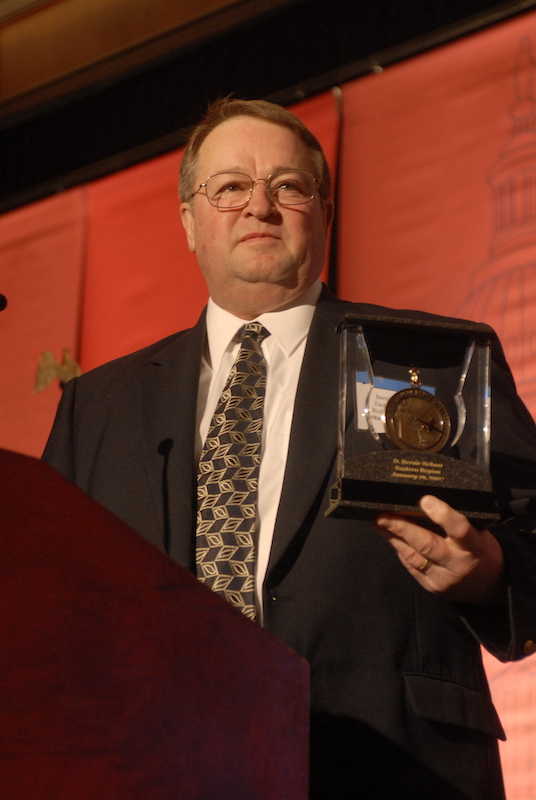
With over 30 years of experience in air traffic control, Bernie Nelson has gained the expertise necessary to spot a potentially dangerous situation, take control, and steer pilots out of danger. This is a skill that controllers learn as they accumulate hours on the job and is hard to replace when the skilled controllers retire. On Tuesday, January 24, 2006, Nelson demonstrated this expertise as he prevented a Beech Barron from descending directly on top of a Lear Jet, as both aircraft attempted to land at Richmond International Airport (RIC).
N45KX, the Lear Jet, was handed off to Nelson from Potomac TRACON (PCT) and Nelson cleared him to land a visual approach onto Runway 20. Meanwhile, N320WD, the Beech Barron, was instructed by PCT to follow the Lear Jet toward RIC and check-in with the tower for a visual approach to Runway 20, directly behind the Lear.
Nelson, who was watching each of the aircraft’s mode-c altitudes on the RACD, noticed the Barron descending out of 2300 feet directly over the Lear prior to checking-in for clearance.
The Barron then checked in with Nelson and Nelson immediately asked the pilot, “Do you have the traffic below you?”
The pilot did not respond so Nelson instructed, “N320WD stop your descent. Do you have the traffic you are following?”
The pilot responded, “We had a Lear we thought we were following but I do not have him in sight at this time.”
In a calm, controlling voice Nelson advised the pilot, “When you lose sight of him, you can’t keep descending. You are right on top of the guy.”
Nelson told the Barron to stay at the current altitude and to fly heading 090 and maintain VFR, thus removing him from the final approach and from directly above the Lear. Nelson then contacted PCT and told them he was sending the Barron back to them for re-sequencing. After a few seconds, the Barron responded that he had the traffic in sight and again asked for clearance. Nelson denied the request, giving the pilot the frequency for PCT.
After the Barron was cleared from above the Lear, Nelson radioed the Lear to continue his approach and to land on Runway 20. The Lear pilot, who was able to hear Nelson move the Barron away from his aircraft, indicated that he had an RA, but did not take action because he knew the controller had the situation under control.
The Lear landed safely, as did the Barron, after circling back around for a second attempt.
With his 30-plus years of experience, Nelson was able to control a situation that could have become disastrous had the Barron continued to descend directly onto the Lear.
“Mr. Nelson’s astute awareness and keen observation of his traffic helped to avert a potentially disastrous outcome between these two aircraft and the lives onboard,” said RIC FacRep Jeff Gaffney. “It is this type of experience and attention to detail that the users of the National Airspace System are going to sorely miss.”
Nelson walked down the control tower steps for the last time on January 3.
View a transcript of event highlights.
Great Lakes Region: David Murphy and Yasemin Parker, Champaign Tower/TRACON
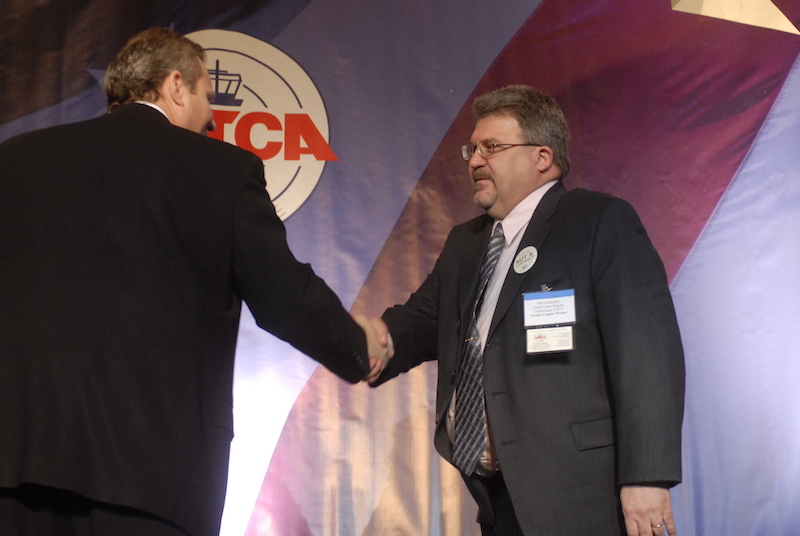
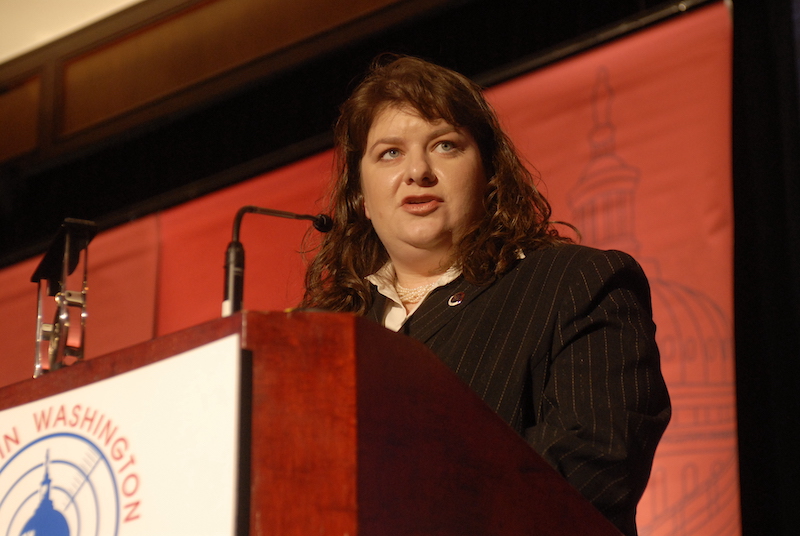
“I would like to take this opportunity to say THANK YOU for saving my life yesterday!”
These were the opening words of an impassioned letter of gratefulness from St. Charles, Mo., pilot Willard W. Nickisch, signed on Sept. 14, 2006. The previous day, Murphy, veteran controller and CMI Facility Representative, and Parker, training on both of CMI’s radar sectors, worked to help Nickisch overcome extreme difficulty in flying his Seneca III and then vectored him to a safe, albeit unscheduled, landing at CMI.
Just as Parker called for a split of the combined radar sectors as traffic started to increase, she noticed the PA34 descending from its assigned altitude. She told Nickisch, who was returning to St. Louis from Michigan, to check his altitude when he reported, “I’m having a problem with my autopilot.” Parker asked Nickisch if he was declaring an emergency. He was.
Nickisch, who had inadvertently turned off his autopilot in a manner that left the aircraft in a full down trim position. He was struggling, and to Parker, seemed out of breath. “I thought he was literally having a heart attack,” she said. The plane pitched over and the pilot responded by pulling back the yoke. “It took both hands and my legs to straighten and maintain altitude after the initial rapid descent,” Nickisch said.
Parker told every other aircraft on the frequency to stand by as she handled the emergency in progress, and also stopped departures. Then, Parker turned over the aircraft to her split position, manned at that point by Murphy, who then worked Nickisch down on a single frequency while Parker dug in and cleaned up the rest of the airplanes that were standing by.
Murphy continued to get information from Nickisch about what was happening in his cockpit. When Murphy learned of the aircraft’s lack of instruments and Nickisch’s diminishing positional awareness, he immediately began setting up for a surveillance approach. Said Nickisch: “(Murphy) was knowledgeable about using the information he had, to tell me when to turn and when to stop the turn, along with allowing me to descend to the prescribed descent altitude.”
Murphy said, “I tried to keep him calm and assured him that he was doing just fine.” At 1.5-2 miles from the runway, Nickisch reported the runway in sight and lowered the landing gear. He was then cleared to land.
CMI controller Karl Jensen said the facility’s entire team provided good service, but added, “these two individuals made the hard decisions that ultimately were the difference between life and death.”
Parker’s trainer that day, Sheri Walsh, wrote glowingly of Parker’s performance in an official FAA report: “To sum this session up in a word… WOW!!!! You handled this operation like most (full performance level controllers).”
Wrote Nickisch, in closing his letter: “I am forever grateful to God (and the U.S. Government) for your being there. Please share my thanks and gratitude to the great people who helped me to live another day.”
Read a transcript of the event highlights.
New England Region: Stephen Schmalz, Boston Center
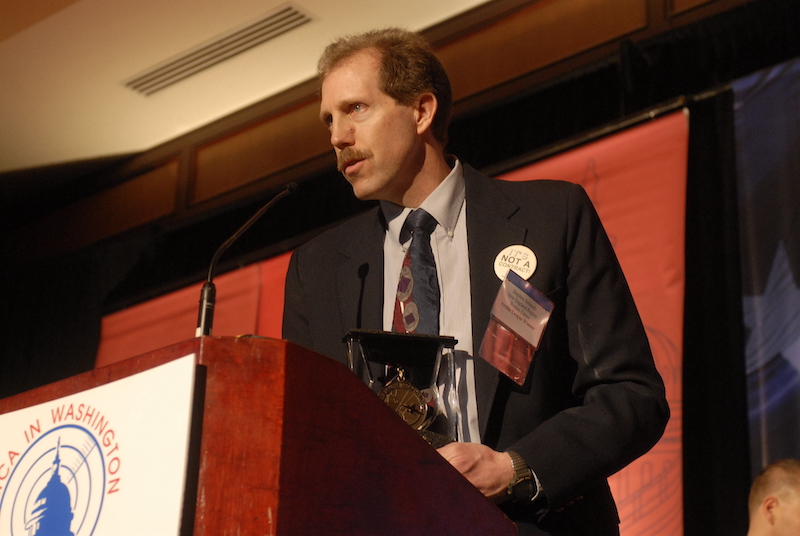
In air traffic control, every day is a new day, a new experience, and a new set of circumstances. Controllers are educated to be alert and prepared for anything and everything. It is not uncommon for a controller to have a day where all the aircraft are running smoothly and the weather is perfect and the next day the aircraft are battling high winds and rain with low visibility. The controller must be prepared for it all.
At the Boston Air Route Traffic Control Center (ZBW), controllers are responsible for all traffic above a specified altitude over Maine, Massachusetts, New Hampshire, Rhode Island, Vermont, and parts of New York and Connecticut, as well as over parts of the northwestern Atlantic Ocean. With airspace this large, the likelihood of something going wrong is high.
During the winter of 2005-06, veteran ZBW controller Stephen Schmalz found himself in radio contact with two separate pilots who had encountered difficult flying conditions and turned to him for help.
The first incident occurred on December 11, 2005, when a pilot en route to Morristown, N.J. (MMU) under visual flight rules suddenly found himself in instrument flight rules conditions. The pilot was not certified to fly IFR and declared an emergency to ZBW. Schmalz was working sector R05 at the time and proceeded to help the distressed pilot.
As the aircraft climbed higher to avoid the clouds, Schmalz solicited meteorological reports from other aircraft in the area and encouraged the pilot to look at his instruments to maintain a straight and level heading until he could be directed below the clouds.
Schmalz soon learned of a five-mile break in the clouds ahead of the aircraft and began to calmly direct the pilot in that direction. Schmalz reassured the pilot and told him to remember to keep a straight and level heading. Once the clouds opened up, the pilot was able to descend safely below and was passed off to New York TRACON (N90) for landing.
Approximately six weeks later, Schmalz found himself again on the other end of the radio with a distressed pilot whose aircraft was experiencing mechanical failure.
N434TB was flying from Charlottesville, Va. (CHO), to the Keene, N.H., Dillant-Hopkins Airport (EEN) when the aircraft’s electrical system died, taking the radio and transponder down with it. The pilot worked to turn off the nonessential electrical components, which allowed the radio to begin working again. He then radioed Schmalz for assistance in landing as soon as possible. Schmalz gathered all the relevant information, including weather reports, airport information, and pireps, and passed it on to the pilot, who requested to divert to Stewart International Airport (SWF) in Newburgh, N.Y. Schmalz vectored the pilot in that direction, lowering him to 7,000 feet. Once he reached that altitude, Schmalz turned the pilot over to N90 for landing approach.
In both situations, Schmalz used his air traffic control knowledge and experience to guide the distressed pilots home. With the help of controllers like Schmalz, the National Airspace System remains the safest in the world.
Read a transcript of event highlights.
Northwest Mountain Region: Ivy Sylvain, Seattle TRACON
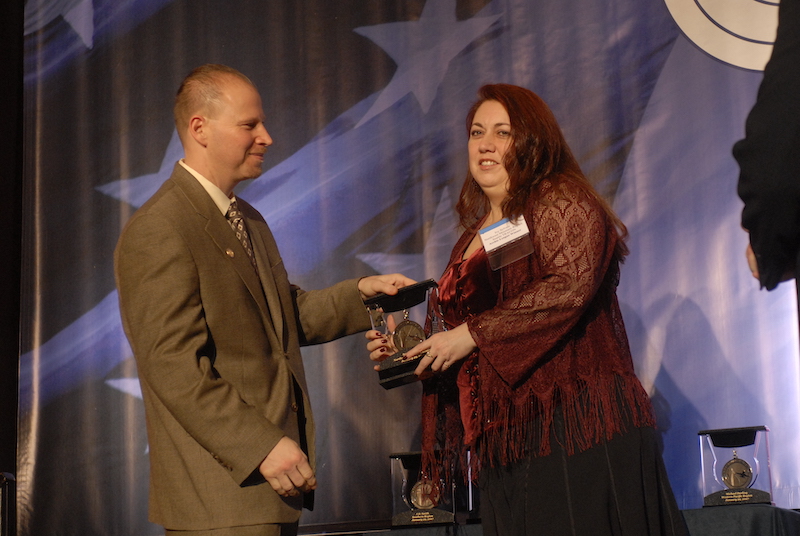
“Seattle Approach, Cessna 6725Foxtrot is with you on 119.2.”
Veteran Seattle TRACON controller Ivy Sylvain picked up the target while handling a heavy load of departure traffic. The pilot of this Cessna had taken off from Bowers Field in Ellensburg, Wash., near the center
of the state, and was headed west to Auburn Municipal Airport, just south of Seattle. Sylvain instructed the pilot to stay in Visual Flight Rules, below the Class Bravo airspace, pointing out that an overcast layer was at 3,000 feet.
The pilot was not qualified for Instrument Flight Rules, nor was his aircraft equipped for IFR. But he soon discovered that expectations of clear weather conditions were wrong. He found himself above a solid cloud
layer and intended to find a hole to descend through. His fuel was low, not enough to return to Ellensburg or to proceed southwest to Olympia, where a hole in the overcast was reported.
Sylvain advised of low clouds in the Seattle area and told the pilot she would work with him to pursue the possibility of getting him down below the cloud layer, back to VFR conditions.
“Uh, it looks like I might be able to get down through something right out in front of me. I’m just going to take a look at it.”
As the Cessna started descending east of Seattle, she asked him how it looked.
“Looks like I have a hole out in front of me. I hope it’s not just shadows.”
This statement “definitely got my heart racing,” Sylvain said. She pulled up information about an airport in the vicinity, Fall City, 25 miles east of Seattle, and told the pilot the runway direction, dimensions and
composition.
A second private pilot, listening in, advised the Cessna of the low ceiling and gave him a stern warning: “I’m not going to tell you that you can’t try this, but I just want to let you know that if you try this and get down there and start fooling around and can’t get to where you want to go, you better have enough gas to get back to where you can go.”
The Cessna pilot reported having the ground in sight and continued his descent. But Sylvain then lost radio contact and by the time she was able to reestablish contact, with the help of a Northwest Airlines pilot, the Cessna was headed the wrong way.
But Sylvain provided course corrections via a second NWA pilot until she lost radar contact. The target reappeared a short distance from Fall City.
Soon after, the second NWA pilot, talking to the Cessna, reported good news to Sylvain: “25Foxtrot has Fall City Airport in sight and he will give you a call when he gets on the ground.”
“I was in the room during this assist, working arrival, and Ivy did a great job,” said Seattle TRACON Facility Representative Dan Olsen.
Said Sylvain: “When it was over, the adrenaline let down and just plain relief almost made me cry. But I wanted to keep working.”
Read transcript of event highlights.
Southern Region: J.D. Smith, Pensacola TRACON
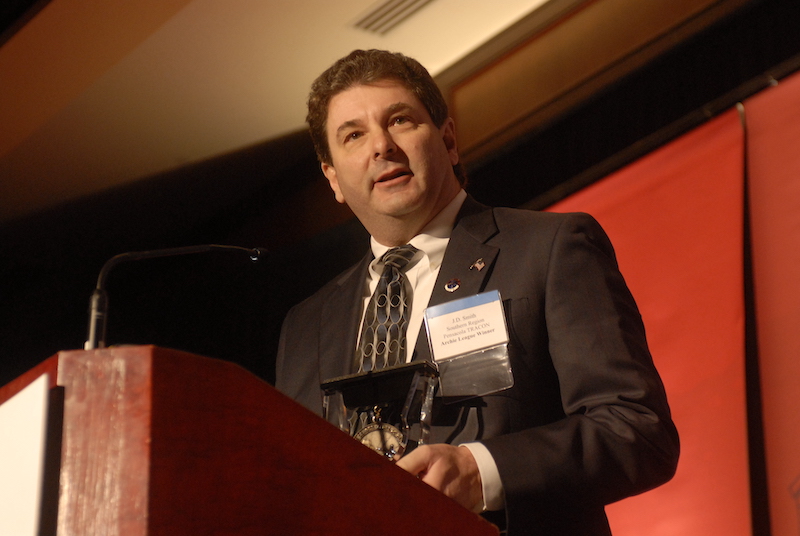
No matter the time, day or night, or whether other people are working in the control tower or not, air traffic controllers must always be alert and prepared for anything.
This was the scenario facing Pensacola TRACON (P31) controller J.D. Smith when he reported for his mid-shift on September 24, 2006. He was working alone in the TRACON while the actual Pensacola Tower was closed for the night. A late-arriving aircraft, a Northwest Airlink inbound to Pensacola from Memphis, was cleared by Smith to land on a visual approach to Runway 8/26 at Pensacola International Airport. Smith told the pilot to switch to an advisory frequency and to cancel IFR on the approach frequency after he landed.
After clearing the plane, Smith continued about his work in the radar room when he noticed on his radar screen that the Northwest Airlink was lined up to land on Runway 17/35 and not the stated Runway 8/26. Runway 17/35 was closed at the time, and had been for a few months. Half of the runway was torn up and heavy machinery and debris littered the other half.
Knowing he did not have the plane on his frequency, Smith grabbed a tunable radio from inside the TRACON and attempted to call the pilot to alert him to his mistake. The call went unanswered. Smith then attempted to radio the pilot on the approach frequency, hoping the pilot was monitoring it. The pilot was and radioed back to Smith.
Smith notified the pilot that he was lined up to land on the closed runway and advised him to shift to the open Runway 8/26. After a few seconds of silence, the pilot realized his mistake and turned toward the correct runway, landing safely.
The quick action on the part of Smith prevented a possible major runway accident on the PNS runway. His alertness and knowledge of the area through the eyes of his radar while alone in the TRACON in the early hours of the morning is a great example of the professionalism of the air traffic controller community.
“This save is remarkable for several reasons,” said NATCA Southern Region Safety Representative Perry Doggrell. “First, PNS tower is closed. Second, Smith was alone in the TRACON, and third, the airspace covered by P31 is quite large. In order for him to see all the airspace, his range on the scope must have been set to the maximum. For him to notice a plane was lined up on the wrong runway, on a 2-3 mile final, from a radar screen, is incredible. There were no windows, so he could not look outside and see the aircraft approaching. He only had his radar screen.”
View transcript of event highlights.
Southwest Region: Borden Byrd, Dallas-Fort Worth TRACON
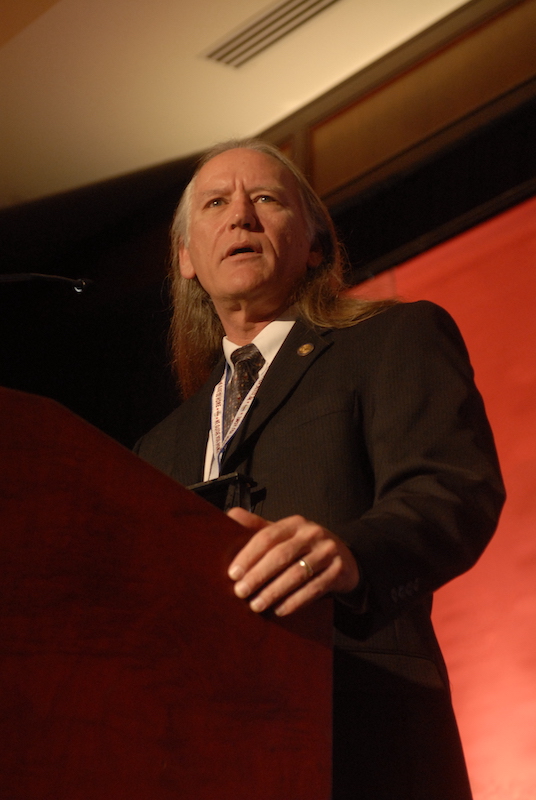
There are seven runways at the nation’s third-busiest airport, Dallas-Fort Worth International. It takes experienced, sharp, and focused controllers – in the control tower at DFW and in the nearby TRACON (D10) – to ensure that the delicately balanced choreography of air traffic proceeds smoothly and safely every hour of every day.
On Aug. 24, 2006, it was the sharp eyes and quick reaction of D10 controller Borden Byrd that averted a possible collision between two jets – an American Airlines MD80 and a United Express regional jet – that had departed simultaneously off parallel runways 17 Right and 18 Left.
The MD80 took off on 17R on an RNAV departure that would have directed the aircraft to depart south with an eastbound turn approximately five miles south of DFW. The RJ took off on 18L on an RNAV departure that would have directed the aircraft to depart south, with a westbound turn approximately five miles south of the airport.
The RNAV departure requires the departing aircraft to dial in the departure runway into their Flight Management System (FMS).
But on this day, the regional jet’s pilots had set an incorrect runway in the FMS. After the jet began its ascent, it turned to the southeast, directly into a path toward that of the MD80. Both jets were approximately 1,500 feet off the ground and going 200 miles per hour.
“There was a trajectory that was begun there that could have put two airplanes together,” said John Nance, a pilot and aviation expert who also serves on the Archie League Awards Selection Committee. “The fact was they left a piece of automation and put them in a bad position.”
But Byrd observed the situation developing and turned the regional jet immediately to the west, out of the path of the MD80.
At their closest proximity, the jets were separated by seven-tenths of a mile and 400 feet – which, as a Dallas television station described it – is less than the distance between home plate and the center field fence at the Texas Rangers’ ballpark, Ameriquest Field.
“In this particular case, a very sharp controller was watching very carefully,” Nance said.
Western Pacific Region: Michael Darling, Los Angeles Tower
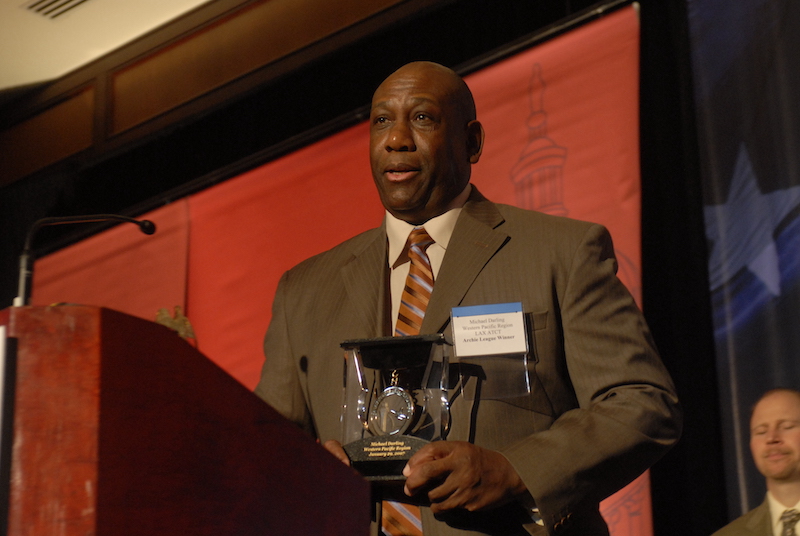
It was, as the Los Angeles Times reported, “the closest call they [controllers] have seen at LAX in seven years.”
But standing between the episode of pilot deviation and the impending disaster near the end of Runway 25 Right (25R) on the afternoon of July 26, 2006, was quick-thinking Michael Darling, a veteran controller at LAX Tower for over 20 years.
The incident began when America West Flight 6008 (ASH6008), a regional jet, landed from Phoenix on Runway 25 Left, the airport’s southernmost runway.
Darling, working the local control position in the tower, instructed the aircraft to depart the runway on Taxiway Mike and hold short of 25R. The pilot read back the hold short instruction.
Meanwhile, just prior to this movement, a departing United Express turboprop (flight SKW6037, to Monterey, Calif.) had been cleared for takeoff on 25R at Taxiway Golf on what is known as an “intersection departure” – taking off less than halfway down the runway.
With the United Express aircraft on its takeoff roll and going beyond the point at which it could have stopped, the LAX local control team watched as the America West aircraft, moving too fast to possibly stop at the hold short line, crossed the runway edge line of 25R. Darling quickly went into action, reacting to the situation and keying his microphone to alert the United Express pilot in a clear, authoritative voice.
“Traffic unauthorized crossing downfield!”
With that warning, the pilot was able to pull the aircraft up early – albeit at a slower speed than normal – and flew over the America West jet by less than 50 feet.
“I believe Mike Darling should be recognized for his quick thinking, as many people would have first tried to talk to the jet crossing the hold lines,” former LAX facility representative Diane Aceves said. “In choosing to speak to the departing United Express pilot, Mike enabled him to avoid a collision.”
In a post-incident report compiled by the FAA, the pilot of ASH6008, in admitting responsibility for the pilot deviation, stated that one of his reverse thrusters wasn’t operating properly but that it was his full intention to hold short as instructed. The pilot said he got confused when he reached the hold line and continued forward onto 25R, then stopped.
An FAA supervisor at LAX said in the report that, “had that been a larger aircraft departing, it would have been far worse,” of an outcome.
LAX controllers told the Los Angeles Times that the incident was the most serious near-collision at the airport since November 1999, when an MD-80 that had just landed mistakenly crossed in front of a departing Boeing 757. The United pilot saw the MD-80 and quickly got airborne, clearing it by 100 feet.
Thanks to Darling’s actions, the event had a safe outcome. Unfortunately, LAX Tower will soon lose Darling’s skills, determination, and experience. He plans on retiring this spring.
“This award is a wonderful retirement gift to a longtime NATCA member,” Aceves said.
President’s Award: Chris Thigpen, Kansas City Center
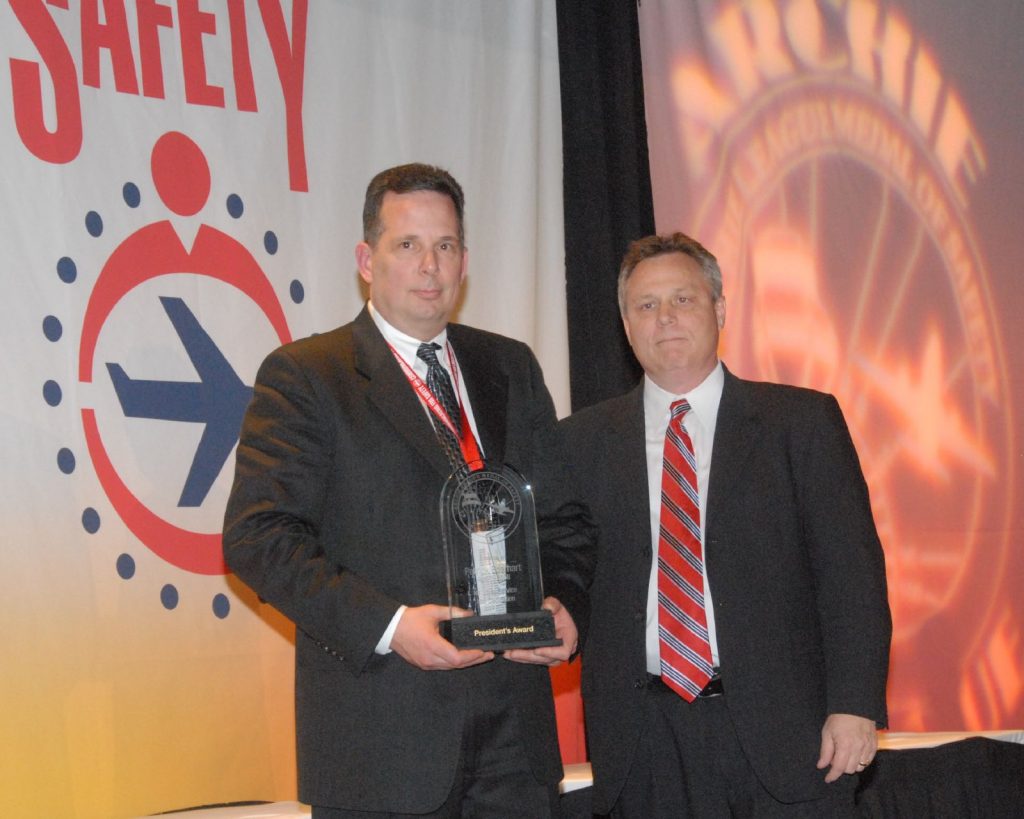
To a distressed pilot, the calm reassurance of an air traffic controller’s voice is their lifeline to safety. Even experienced pilots encounter trouble and must rely on controllers to guide them home. On Oct. 10, 2006, Charles Schultz, piloting his Beech Bonanza (N1801V), found himself in this situation and turned to Kansas City Center (ZKC) controller Chris Thigpen for guidance.
Schultz was headed from Scott City, Kan. (TQK), to Hays, Kan. (HYS), when another ZKC controller, John Bloomingdale, noticed the Bonanza making erratic turns. He radioed Schultz to ask his heading and when it did not match what the radar indicated, Bloomingdale assigned Schultz a different heading. But Bloomingdale knew the Bonanza was in trouble.
Bloomingdale declared an emergency and turned to Thigpen, who was working the next position, for help. Bloomingdale knew that Thigpen, a private pilot, would be able to assist Schultz. This decision proved correct, as Thigpen would spend the next 30 minutes guiding the Bonanza to safety.
Thigpen sat down next to Bloomingdale and, according to ZKC Facility Representative Scott Hanley, “it was as if Thigy was a paramedic walking up to a train wreck. He was assessing everything, listening to John [Bloomingdale], watching N1801V, listening to the supervisor, and checking weather at Great Bend, Kan. (GBD), HYS, and Russell, Kan. (RSL) all in a matter of seconds. Then Thigy took charge.”
Thigpen cleared all other aircraft from the frequency and focused on the Bonanza. He realized Schultz was suffering from spatial disorientation and knew that he needed to level his wings, watch the artificial horizon, and keep his eyes inside the aircraft. After 10 minutes of working with Schultz to level the plane and stay on a correct heading, Thigpen took the extra step of establishing a personal relationship with the pilot.
Thigpen: N1801V, what’s your name?
N1801V: Charles Schultz.
Thigpen: Hey Charles, my name is Chris. We are going to point you out toward Great Bend, Kan.
N1801V: That’s great.
From that point on, Thigpen referred to N1801V as Charles. Thigpen even asked him if there was anyone he could contact for him to let them know he would be landing in Great Bend instead of Hays.
With Schultz experiencing spatial disorientation, his instruments were useless. Thigpen took away his instruments, gave him no-gyro vectors all the way and kept repeating for Schultz to keep his eyes inside the plane. As the Bonanza approached Great Bend, Thigpen had a fellow controller radio another aircraft in the area to turn the lights on at Great Bend, so Schultz would be able to locate the airport. “Thigy essentially flew the airplane, completed the checklists and ensured the airport was lit for Charles,” added Hanley.
Finally, after thirty minutes of vectoring, the airport was in sight. Schultz landed the plane safely and then called ZKC to personally thank Thigpen. “I really needed you tonight and you really came through,” he told Thigpen.
Because of Thigpen’s calm and reassuring voice, Charles Schultz was able to make it home safely that night.
BELOW: Watch the award presentation.
BELOW: Watch and listen to highlights from this save event.
Honorable Mention
Central Region
Scott Vancura, Lincoln ATCT
Eastern Region
Joy Aldrich, Albany ATCT
James Boshek, Albany ATCT
Brent BeVier, Albany ATCT
Jerry Turnball, Philadelphia ATCT
Kristen Laubach, Philadelphia ATCT
Rick Mathis, Philadelphia ATCT
Brett Steinle, Pittsburgh ATCT
Albert Herazo, Pittsburgh ATCT
Jim Mostrando, Roanoke ATCT
Mark Hughes, Washington Center
Amber Mauro, Washington Center
Stephen Pologruto, Washington Center
Great Lakes Region
Robert Nicholas, Chicago TRACON
Don Wishowski, Chicago TRACON
Todd Parham, Cleveland Center
Stacey Parham, Cleveland Center
Scott Thornton, Cleveland Center
John Daniels, Cleveland Center
Dave Riley, Cleveland Center
Trent Tyler, Evansville ATCT
Peter Holysz, Kalamazoo ATCT
Ryan Ray, Kalamazoo ATCT
Davyd Swanson, Kalamazoo ATCT
Tom Goldman, Milwaukee ATCT
John Hermes, Milwaukee ATCT
Kim Bowe, Minneapolis Center
Glendon Rice, Sioux Falls ATCT
Northwest Mountain Region
Don Niemiec, Seattle TRACON
Southern Region
Wayne Dombroski, Atlanta TRACON
Steve Jubb, Atlanta TRACON
Doug Blythe, Florence ATCT
James Fleming, Greenville-Spartanburg ATCT
Cristina Fitz, Louisville ATCT
John Ramirez, Orlando ATCT
Marco Colon, San Juan CERAP
Southwest Region
Don Craig, Dallas-Fort Worth TRACON
Phil Enis, Fort Worth Center
Phil Layman, Fort Worth Center
Scott Keller, Tulsa ATCT
Western Pacific Region
Michael Gabrick, Phoenix TRACON
Joseph Gramm, San Francisco ATCT
Award of Special Recognition: Pat Hart, Dallas-Fort Worth TRACON (D10)
The Archie League Medal of Safety Judges Panel, while selecting Borden Byrd’s save as the best of the Southwest Region’s five nominations, were so impressed with fellow D10 controller Pat Hart’s work on February 7, 2006 in quickly separating two converging aircraft near Dallas Love Field that they have presented Hart with an award of special recognition.
A Citation 550 had departed DAL and was assigned an altitude of 5,000 feet. At the same time, a PC12 was inbound to DAL, also at 5,000 feet. Hart directed the Citation to climb to 8,000 feet on the same heading and continued about his work on his sector. Soon after, he noticed the Citation had initiated an unauthorized turn to the left, placing it on a collision course with the inbound PC12. Hart immediately issued a right turn and 180-degree heading to the Citation. With just seconds to spare, the Citation pilot located the PC12 and was able to maintain separation.
Photo Album: The 4th Annual Archie League Medal of Safety Awards Banquet
View photo album here.

